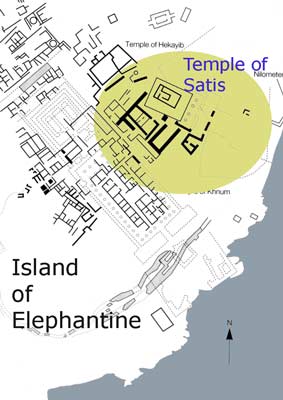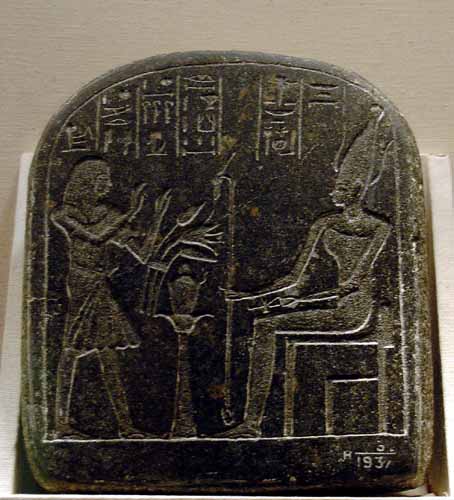
Granite stela of Rmry, showing the owner offering lotus flowers to the goddess Satis. Aswan c.1300 BC. Manchester Museum.
-

- Relief from the restored temple of Satis
showing Tuthmosis III and Satis with her distinctive
head-dress

- Elephantine is an island in the Nile which is opposite Aswan. The southern tip of the island is the site of an ancient settlement (of the same name). It lay on the boarder with Nubia and was once of strategic and military significance and was fortified from the Early Dynastic Period.
-
- One of the temples on the island is the temple of Satis. The temple was built for Thutmose III (Menkheperra, c.1479-1425 BC) and was restored by the German Archaeological Institute in the 1970s and 1980s under the direction of Dr Gunter Dreyer.
- Because the island has restricted space the builder sealed off the earlier temples under multiple floors and built over the top. Beneath the 18th Dynasty floor was a 12th Dynasty structure and under that a 11th Dynasty one. Beneath that is a 6th Dynasty temple and finally a Early Dynastic structure was found. This is very different from other temple in Egypt where the 'old' structure was simply removed to build the 'new'.
- The Early Dynastic structure is one of the earliest found in Egypt. It was a small sanctuary utilizing an existing natural niche in the rock and it expanded into small rooms from which many small votive objects were found. Its not sure which gods were worshiped there. However, Tuthmosis's temple was dedicated to Khnum, Satis and Anket - all local deities.
-
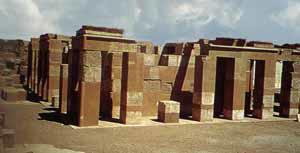 The
German excavations at Elephantine have added significantly
to knowledge of Egyptian temple development. This small town
site on the southern tip of Elephantine Island was built
over a core of natural rounded granite boulders. Its
development as a town seems to have occurred during the
early Old Kingdom. In 1972-3 a shrine serving this early
town was discovered. It lay on the north side set among the
boulders. This particular setting has provided archaeology
with a so unique set of circumstances. At other temple
sites, on flatter ground, the rebuilding and enlargement of
temples in later periods inevitably did much damage to the
earliest shrines. At Elephantine the builders of later
temples to work within the space restrictions created by the
boulders surrounding the early site, simply filled the site
in, and then paved it over. By sealing the early
shrine and its associated floors and artefacts a
archaeological record gives us for the first time a fairly
complete picture of what an early local shrine looked like.
The
German excavations at Elephantine have added significantly
to knowledge of Egyptian temple development. This small town
site on the southern tip of Elephantine Island was built
over a core of natural rounded granite boulders. Its
development as a town seems to have occurred during the
early Old Kingdom. In 1972-3 a shrine serving this early
town was discovered. It lay on the north side set among the
boulders. This particular setting has provided archaeology
with a so unique set of circumstances. At other temple
sites, on flatter ground, the rebuilding and enlargement of
temples in later periods inevitably did much damage to the
earliest shrines. At Elephantine the builders of later
temples to work within the space restrictions created by the
boulders surrounding the early site, simply filled the site
in, and then paved it over. By sealing the early
shrine and its associated floors and artefacts a
archaeological record gives us for the first time a fairly
complete picture of what an early local shrine looked like.
-

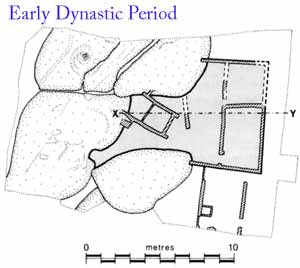 The
first sanctuary was set in a corner at the back of a square
space occupying the natural niche between the boulders. What
the object of veneration was is not known. Nor did the cult
leave any marks on the actual rock faces, which seem to have
been left in their natural state. But whatever the cult
image was, it was protected by two small brick rooms. The
space in front was enclosed by further brick walls to create
a courtyard, or just possibly a roofed hall. The date of
this earliest phase is within the Early Dynastic Period,
although some of the pottery found is Pre-Dynastic.
The
first sanctuary was set in a corner at the back of a square
space occupying the natural niche between the boulders. What
the object of veneration was is not known. Nor did the cult
leave any marks on the actual rock faces, which seem to have
been left in their natural state. But whatever the cult
image was, it was protected by two small brick rooms. The
space in front was enclosed by further brick walls to create
a courtyard, or just possibly a roofed hall. The date of
this earliest phase is within the Early Dynastic Period,
although some of the pottery found is Pre-Dynastic. - The basic form of the shrine, a niche in the rock served by modest mud brick shelters, was kept throughout the Old Kingdom, and apparently on until the time of the reunification of Egypt in the 11th Dynasty, a period of six centuries. Over this time the main changes were to replace the small shrine with a partition wall across the whole rock niche and to provide a larger hall, increasing generally the thickness of the walls. In the centre of the hall stood a square pedestal, 0.9 by 1.1 m, constructed from layers of brick separated by layers of matting for extra strength. A wooden pole stood against each corner. This could have been a north facing canopied podium to support a portable divine image. The whole little complex was then protected by an outer corridor and second wall.
- If the simplicity of the early shrine is striking, corresponding to the great age of pyramid building in the north, so also is the relative crudeness of most of the votive objects recovered from the associated floor levels. These seem to relate to a period of religious belief and practice separate from the one to which we are accustomed in ancient Egypt. The 'formal' theology which decorates tomb and temple in Egypt does not match this material, which thus serves in its own right as the main evidence for an aspect of ancient religion. The votive objects were numbered in their hundreds. Many were found scattered in the various levels, but one particular concentration seems to have formed during the 5th Dynasty. Most were made from faience (shiny blue/green glazed synthetic material which was the ancient equivalent to modern plastic), but pottery, ivory, limestone, and sandstone were used as well. Many of the objects are related to children, which has led to speculation that the site was frequented by people either hoping for children or thanking god for them. These objects can be grouped as:
- human figures (both adults and children) the most numerous group being children with fingers at their mouth; a unique figure is the lower part of a seated king, which bears a single sign interpreted as reading the name of the 1st Dynasty King Djer (although from a 6th Dynasty level)
- baboons/apes, a few also with fingers to mouth
- number of animals and birds, the former including frogs, crocodiles, lion, pig, hippopotamus, cat, and hedgehog
- oval faience plaques bearing at one end the head of an animal, apparently a hedgehog (forty-one examples of this curious design)
- faience tiles of the type otherwise used in wall inlays, many with an incised or painted sign on the back
- faience objects of various forms, mainly large beads, necklace spacers, and model pots
- natural flint pebbles of curious and bizarre shapes
- flint knives
- In addition to these groups a number of objects were found bearing the names of King Pepy I and King Pepy II of the 6th Dynasty. Some of them, perhaps all, were in celebration of the first Sed-festival of these kings. One was a vase in the form of a squatting ape holding its young. The remainder were faience plaques (mostly for Pepy I). The 6th Dynasty provided also the only inscriptions found in position - two graffiti of King Merenra and of King Pepy II scratched on one of the granite walls of the niche, the former commemorating a military campaign into Nubia.
- This material comes from a series of stratified layers which range through all of the first six dynasties. Yet vertical position does not assign a date of manufacture to a piece but shows when it was discarded (some pieces may have been very old when finally buried in the floor of the shrine). The traditions involved clearly began in the Early Dynastic Period, and set a tone which lasted for a long time. The detailed study of the material piece by piece shows that whilst the Early Dynastic Period is the date for the origination of pieces it is not necessarily the date for manufacture of every piece. The tradition ran on through the Old Kingdom and at the end the faience plaques bearing the names of 6th Dynasty kings were being produced in the same crude way. A small group of craftsmen attached to the shrine may have met a demand for temple votive objects, retaining forms and techniques over a long period (the entire first six dynasties).
One other conspicuous feature of this group of objects, which also applies to similar groups from Hierakonpolis and Abydos, is the absence of representations which can be associated with the local cult deity. If we take all the Early Dynastic Period and Old Kingdom material from the Elephantine on its own, it does not tell us to which deity the temple was dedicated.-
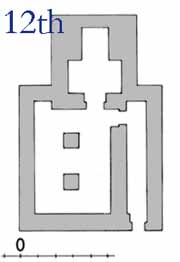
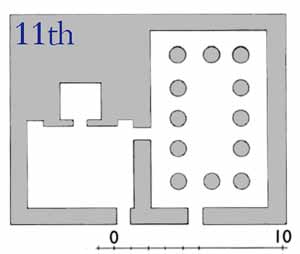 In
the 11th Dynasty an new shrine was laid out by
Mentuhotep II (Nebhepetra),
employing areas of decorated stone. From what little direct
evidence survived, its plan seems to have been a
continuation of the existing one. In turn this shrine was
replaced at the beginning of the 12th Dynasty by
Senusret I (Kheperkara) with a
limestone building with a high quality of decoration.
It seems from the extent of the stone pavement, which is all
that is left, that the 12th Dynasty temple was also within
the same area as the Old Kingdom temple.
In
the 11th Dynasty an new shrine was laid out by
Mentuhotep II (Nebhepetra),
employing areas of decorated stone. From what little direct
evidence survived, its plan seems to have been a
continuation of the existing one. In turn this shrine was
replaced at the beginning of the 12th Dynasty by
Senusret I (Kheperkara) with a
limestone building with a high quality of decoration.
It seems from the extent of the stone pavement, which is all
that is left, that the 12th Dynasty temple was also within
the same area as the Old Kingdom temple. - The stone blocks from the 11th and 12th Dynasty shrines mention the three local deities which were the principal ones at Elephantine - Khnum, Satis, and Anket. Their forms were distinctive: Khnum was a ram, and the others were ladies with unusual head-dresses. Nothing relating to these forms occurs amongst the votive material. The explanation probably involves two factors. One is that Early Dynastic Period formal religion had a range of emphases somewhat different from later times, although the early images themselves were preserved by later tradition, sometimes with changed identifications. The cults of baboons and scorpions are two examples. The other is that whilst the shrine came at some time (presumably in the Old Kingdom) to have a formal dedication recognized by priests and kings, for the local population it served as the focal point for beliefs which had an independent origin and existence of their own. The most likely explanation for the figurines of children, for example, is that they mark an approach to the shrine by a local person before, or after, or in the hopes of, successful childbirth. Beliefs of this kind found no expression in formal theological texts. They are one aspect of the hidden dimension of life and society in ancient Egypt.
-
 In
the 18th Dynasty the temple took on a very different aspect.
The existing stone shrine was removed, the ancient niche and
court were filled with blocks of stone to build the level of
the ground up around 2 meters to the top of the granite
blocks. On this new higher and level surface, which was
paved, a larger stone temple was erected during the reign of
Tuthmosis III (some sources indicate that this was
constructed by Hatshepsut).
In
the 18th Dynasty the temple took on a very different aspect.
The existing stone shrine was removed, the ancient niche and
court were filled with blocks of stone to build the level of
the ground up around 2 meters to the top of the granite
blocks. On this new higher and level surface, which was
paved, a larger stone temple was erected during the reign of
Tuthmosis III (some sources indicate that this was
constructed by Hatshepsut). - The 'Mature Formal' phase had arrived, yet even at this time the builders tried to maintain some contact with the original sacred ground which they had so thoroughly buried. The new sanctuary was sited over the old one, the conservative Egyptians were attempting to remove the original temple but to 'update' it whilst maintaining the correct level of respect. A link to the old temple was preserved by retaining a direct 'communication' by means of a stone-lined shaft which descended through the foundations to the floor of the early sanctuary.
-
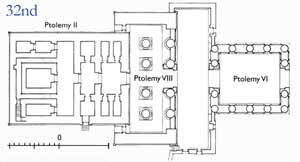 Following
the long tradition of over-building, in Satis's case
stretching back over 2,000 years), the 18th Dynasty temple
was over-built during the Ptolemaic Period, by Ptolemy II,
VI and VIII. This building was fronted with a
traditional open pronais and demonstrates a strong
similarity to other preserved temples [good
example is Edfu] built during this period. Only
traces of this temple's foundations remain and the current
temple has been reconstructed by the
German Archaeological Institute from the Ptolemaic
blocks in the form of the 18th Dynasty temple.
Following
the long tradition of over-building, in Satis's case
stretching back over 2,000 years), the 18th Dynasty temple
was over-built during the Ptolemaic Period, by Ptolemy II,
VI and VIII. This building was fronted with a
traditional open pronais and demonstrates a strong
similarity to other preserved temples [good
example is Edfu] built during this period. Only
traces of this temple's foundations remain and the current
temple has been reconstructed by the
German Archaeological Institute from the Ptolemaic
blocks in the form of the 18th Dynasty temple.
-
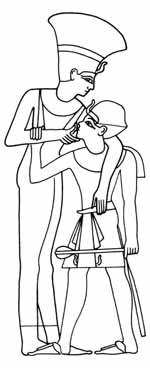 Anket
was the goddess of the cataracts of the Lower Nile. She is shown wearing on
her head a modius [glossary] from
which stem ostrich feathers. Her cult can be traced back to
the Old Kingdom in Upper Egypt and her cult is focuses in
Elephantine and also Seheil (an island south of Aswan).
Although she is associated with Lower Nubia she is not a
foreign goddess but is linked top the Egyptian belief in a
deity beyond the southern frontier.
Anket
was the goddess of the cataracts of the Lower Nile. She is shown wearing on
her head a modius [glossary] from
which stem ostrich feathers. Her cult can be traced back to
the Old Kingdom in Upper Egypt and her cult is focuses in
Elephantine and also Seheil (an island south of Aswan).
Although she is associated with Lower Nubia she is not a
foreign goddess but is linked top the Egyptian belief in a
deity beyond the southern frontier.
![]() Her
name could mean the 'embracer', benignly as a nurse or as a
strangler. This implies a dual character like Hathor.
She is the daughter of Re and takes the role of divine child
of Khnum and Satis in the New Kingdom.
Her
name could mean the 'embracer', benignly as a nurse or as a
strangler. This implies a dual character like Hathor.
She is the daughter of Re and takes the role of divine child
of Khnum and Satis in the New Kingdom.
The temple of Beir el-Wali built by Ramesses II in Lower Nubia has niches for statues of Anket and Khnum. The sanctuary is also decorate with fine scenes including one of Ramesses being suckled by Anket.
-
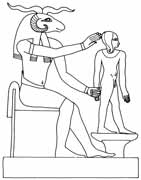 Khnum
is the ram-god creator of life on the potter's wheel, he was
called 'high of plumes, sharp of horns', had primarily
an association with the Nile cataract. He controls the annual
inundation of the river from the caverns of Hapy, the god
personifying the flood itself.
Khnum
is the ram-god creator of life on the potter's wheel, he was
called 'high of plumes, sharp of horns', had primarily
an association with the Nile cataract. He controls the annual
inundation of the river from the caverns of Hapy, the god
personifying the flood itself. - His importance at Elephantine can be traced back to the early dynastic period although the archaeological evidence is predominantly from the New Kingdom and Graeco-Roman period. Rams sacred to Khnum have been discovered on Elephantine Island, mummified, adorned with gilded head-pieces and buried in stone sarcophagi. A stela was carved on a dominant rock on Seheil Island overlooking the first cataract which emphasises the antiquity of Khnum's cult at Elephantine. The inscription itself is a Ptolemaic copy (or forgery) of an original document dating to the reign of King Djoser (3rd Dynasty). There has been a seven year famine which Djoser is trying to halt. Khnum relents from preventing the Nile flood, on being assured of his temple's renovation and regular income of Nubian wealth, and Egypt prospers again.
![]() In
his supervision over the cataract region he is assisted by the
goddesses Satis and Anket. He was also regarded in this aspect
as lord of the cataract as the 'Ba' (soul) of the sun-god, hence
his name becomes Khnum-Re. This strong connection with the river
lies behind one of his titles `lord of the crocodiles',
intensified by the presence of the goddess Neith, mother of the
crocodile-god Sobek, as the most important guest deity in his
temple at Esna.
In
his supervision over the cataract region he is assisted by the
goddesses Satis and Anket. He was also regarded in this aspect
as lord of the cataract as the 'Ba' (soul) of the sun-god, hence
his name becomes Khnum-Re. This strong connection with the river
lies behind one of his titles `lord of the crocodiles',
intensified by the presence of the goddess Neith, mother of the
crocodile-god Sobek, as the most important guest deity in his
temple at Esna.
His other major role is probably derived from the procreative powers of the ram and the life supporting river which make him eminently suitable as a creator-god. The iconography represents Khnum seated before a potter's wheel on which stands the being which he has moulded into existence. The god normally performs this task at the behest of another deity, e.g. in the theogamies on Theban temple walls or in the story of the Two Brothers where Khnum is instructed to fashion a wife for Bata. It seems that Khnum breathes in the life force to the created being, as mentioned in the Westcar Papyrus where after the divine birth of the first three kings of the 5th dynasty Khnum is said to put 'health' into each of their bodies.
It is the aspect of Khnum as 'potter' that is especially venerated in his main cult centre north of the first cataract at Esna. This temple which survives only in the form of one hypostyle hall surrounded by the modem conurbation is also sacred to Khnum in a manifestation strongly allied to the air-god Shu as war-champion of the sun-god. Important hymns provide a manifesto of the priests' belief in the supremacy of their god of the potter's wheel responsible for fashioning gods, mankind, cattle, birds and fish. The different speeches of the human race are also his gift. His consort at Esna (Neith having a totally independent role in this temple) is a minor lioness-goddess called Menhyt.
